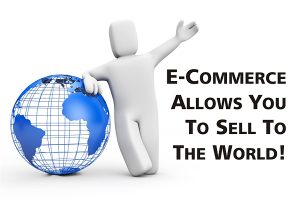In this blog post, Pramit Bhattacharya, a student of Damodaram Sanjivayya National Law University, writes about the impact of e-commerce on SMEs and how the relationship between e-commerce and SMEs has aided in the growth of India’s economy.
With the emergence of a global economy, e-commerce is becoming a strong catalyst to expand business activities and build an active customer base. It is not very surprising to see the revolutionary way in which e-commerce has helped the business industry. The integration of information and communication has totally changed the relationship between the organizations, the consumers and those who act as mediators between the organizations and the consumers. The use of information technology has not only enabled greater consumer participation but has also helped in mass communication along with reduced costs.
But before going into the details of the impact that e-commerce has on SMEs, let us analyze the opportunities, challenges, barriers and drivers of e-business.
| Opportunities | Challenges |
| Saving of Costs | Lack of awareness among SMEs |
| Better information about the needs of the customers and the market overall | Economic return of e-commerce |
| Multiple Channel approach and increased turnovers due to online buying and selling | High concentration of retailers leading to very high levels of competition |
| Enablers | Barriers |
| Changing lifestyle of people with more inclination towards technology. | Security and trust issues. |
| New and unique private labels for the business. | Lack of interest among many retailers to carry on their business on an online platform. |
| Improving technology which increases the efficiency of the supply chain. | Lack of information technology skills among retailers. |
Growth of E-Commerce in India
In the year 2014, the number of internet users in India stood at around 280 million and it was speculated that the number would rise to almost around 640 million by the year 2019.[1] An increase of almost 70 million Internet users in a year is a big big thing. The rise of mobile internet users is also expected to touch some astonishing numbers at 457 million by the year 2019.[2] Compare this with the projected growth of e-commerce in India by the year 2020, it is expected to touch USD 80 billion.[3] The analogy seems pretty clear. We are turning into an internet loving nation!
Role of SMEs in growth of Indian Economy
SMEs contribute immensely to the economy of the country. They can be termed as the backbone of the economy. Their contribution to the service sector is also significant. The number of SMEs in India right now comprises of around 6,000 micro-clusters and 1,157 industrial clusters.[4] Their contribution towards the GDP stands at 17 % and their contribution towards Industrial output and Exports stands at 45% and 40% respectively.[5] Considering these stats, the importance of SMEs in the growth of the economy cannot be denied in any manner. There are close to 48 million SMEs in India if the total of two above-mentioned clusters is considered and these SMEs around 40% of the country’s workforce.[6]
This growth can be further stimulated by exploiting the growing internet penetration in India. The SME sector has also started embracing the technology available to them and is now eager to tap into their potential as internet sellers where they can reach more of shoppers and consumers across the country.
The obvious advantage
Information Technology has come out as a game-changer in almost every walk of all. Book your tickets, pay your bills, transfer your money, entertain yourself, it is all there. So, it will not be wrong to say that the use of internet has acted as a game changer even for business activities across the globe. In India, SMEs have been operating in a traditional manner and have been dependent on domestic trading activities for a long time. But with the growing rate of internet penetration, SMEs in India are also gradually modifying their activities to grab opportunities to trade globally through e-commerce. It is very fascinating to note that around 43% SMEs are now involved in online transactions. These SMEs have an enhanced customer base, better employment opportunities and increased profits. And the trend is on a rise, wherein according to survey almost 565 SMEs believe that use of e-commerce will boost their business growth.[7] It was also observed that the SMEs who used the internet extensively had a growth rate of around 19 % as compared to those who did not put the use of Information Technology in an extensive manner. The growth rate of such SMEs was recorded at around 13%.[8] Those SMEs who used the internet extensively for their business purposes also recorded export values which were approximately twice of those SMEs which did not use much of internet for their business activities.[9]
The traditional SMEs have not experimented much and have stuck to their core activities while those who have entered the domain of e-commerce has not only seen a growth in their business but also a growth in their status quo. It has also been ascertained that around 98 % of the SMEs who use Information Technology and e-commerce contribute to the total exports of the country while only 11% of the traditional SMEs are contributing towards the total export values.[10] This gap between the tech using SMEs and traditional SMEs can be explained by the fact that e-commerce goes beyond the geographical boundaries and provides a level playing field. E-commerce increases the trade visibility of the seller among the buyers who are located in far flung geographical regions.
Potential Benefits to SMEs
-
Increase in revenues
One major disadvantage of being offline is that you are cut off geographically, and more often than not, incremental efforts are made to expand the customer base. This takes a long period. On the other hand, e-commerce helps SMEs carry on their business activities transcending geographical barriers, thereby increasing the customer base, sales, and revenue. It has been perceived that due to the increased speed to market and a global customer base, an SME can boost its revenues by 51 %. Another benefit of e-commerce is that there is a prompt feedback channel through which any complaint or mistake can be made good immediately. The referral system on the internet also helps the business to tap into more potential customers.[11]
-
Low Marketing and Distribution Cost
There is a very sharp rise in competition these days. Businesses try to draw in as many customers as possible to beat their rivals. To do this, they spend heavily on traditional and digital media. By adopting e-commerce methods, the SMEs can reduce their marketing costs drastically by cutting down on expenses of trade shows, enormous offline advertisements and call centers, thereby optimizing their spending. These savings can reduce their expenditures up to 60-80 %.[12] Moreover, adoption of e-commerce methods reduces the traditional marketing cost and the cost of opening a store in multiple places also.
-
Increase in Profit Margin
SMEs can take advantage of a third-party trading platform with a very little or no investment by implementing e-commerce methods. They can host and develop their online storefront and also manage logistics, packaging and, warehousing. The reduction in overhead costs of these activities can potentially increase the profits of SMEs by 49%. When costs are reduced, the same resources can be used to develop a better and more competitive pricing strategy which will have a constructive impact on the profit margins. Adoption of e-commerce also cuts out the middle-man between the SMEs and the consumers, thereby cutting down cost further and increasing profits.
-
Better Accessibility and Geographical Reach
The internet is not restricted by any geographical limitations. The seller can connect to several buyers across different geographical areas. In the virtual marketplace, geographical boundaries disappear and business can go on 24×7 without any time zone restrictions.
-
Faster Approach to Market
A key factor in increasing business is to come up with the product in the market before your competitor does. Time is the essence where the window of demand for any specific product is very short. E-commerce provides the ability to SMEs to approach the market faster by avoiding possible chaos in the supply chain. The redundant processes can be eliminated, and the process of communication can be streamlined to reach the customer as quickly as possible.
-
Better Experience for the Customers
In today’s competitive business world, the principle ” the customer is the king”, holds the center stage. E-commerce helps the SMEs to provide a better experience to the customers. Optimized after-sale services, quick responses to the inquiries of the consumer, and an interactive and informative process of transactions creates a strong and loyal customer base which help the SMEs in the long run as these loyal customers themselves act as strong brand advocates.
Why the usefulness and significance of e-commerce shouldn’t be ignored?
- Not having a virtual presence, or for that matter even having a poorly and haphazardly designed website can hamper the growth of the business. Especially in business sectors that are more customer-centric like export, tourism, and retail, not having an online platform to showcase and exhibit your products can be disadvantageous for the business.
- When the world is turning more and more towards technology, ignoring it can be harmful. Opting for ways which are not fit according to the ways of the ever changing society can cripple the business and without the competitive edge, survival may become difficult.
- Presently, many SMEs lack an organized central database to keep track of customers and database. This causes some difficulties in carrying out marketing and communication activities efficiently. E-commerce presents the solution for this problem.
A more opportune moment cannot be imagined for the SME sector. The future is full of exciting prospects for them, and a lot of opportunities are up for grabs by the virtue of an e-commerce boom in India. What remains to be seen is how much SMEs act in a street smart way and use the opportunity that is presented to them in the form of a catalyst to expand their business.
Footnotes:
[1] #shootingforthestars, FCCI-KPMG in India report on Media and Entertainment, 2015
[2] Ibid.
[3] ‘India Internet-Unlocking the potential of billion digital users,’ Goldman Sachs, 04 May 2015
[4] India SMB Market: Monitoring Emerging Markets, Nasscom, Frost, and Sullivan, 2014
[5]http://articles.economictimes.indiatimes.com/2013-06-09/news/39834857_1_smes-workforce-small-and-medium-enterprises
[6] The Indian SME Survey, Firstbiz-Greyhound, 2014-15
[7] The Status of e-commerce Among Indian MSMEs, SMEStreet Survey, 2015
[8] The Internet Economy in G-20, BCG Analysis
[9] The great transformer: The impact of the Internet on economic growth and prosperity, McKinsey Global Institute
[10] The Internet Economy in the G-20: The $4.2 Trillion Growth Opportunity, BCG Analysis
[11]The Status of e-commerce Among Indian MSMEs, SMEStreet Survey, 2015
[12] Industry Discussion conducted by KPMG in India, 2015
 Serato DJ Crack 2025Serato DJ PRO Crack
Serato DJ Crack 2025Serato DJ PRO Crack














 Allow notifications
Allow notifications



